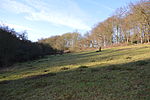Ashridge Priory
1283 establishments in EnglandAshridgeAugustinian monasteries in EnglandChristian monasteries established in the 13th centuryLittle Gaddesden ... and 2 more
Monasteries in HertfordshireSource attribution

Ashridge Priory was a medieval college of Austin canons called variously the "Brothers of Penitence" or the "Boni Homines". It was founded by Edmund of Almain in 1283 who donated, among other things, a phial of Christ's blood to the abbey. It was granted to Mary Tudor, Queen of France and later became the private residence of the future queen Elizabeth I. It was acquired by Sir Thomas Egerton in 1604 and then passed down to the Duke of Bridgewater before being demolished.
Excerpt from the Wikipedia article Ashridge Priory (License: CC BY-SA 3.0, Authors, Images).Ashridge Priory
Hillingdon Road, Dacorum Little Gaddesden
Geographical coordinates (GPS) Address Nearby Places Show on map
Geographical coordinates (GPS)
| Latitude | Longitude |
|---|---|
| N 51.799 ° | E -0.56 ° |
Address
Hillingdon Road
HP4 1NS Dacorum, Little Gaddesden
England, United Kingdom
Open on Google Maps










